“We exist to stir and collect creative responses to the emergency.”
The mobile and digital Climate Museum UK.
Bridget McKenzie in conversation with Elke Zobl and Timna Pachner
Bridget McKenzie is the initiator of the Climate Museum UK. After working in museums and not being able to address the global climate crisis properly there, she felt the urge to create a very particular museum in order to “stir and collect creative responses to the emergency”. In the following interview she talks about initiating Climate Museum UK, the formats, materials and methods they are implementing there, and why the Climate Museum UK is more than a museum after all.
Could you please tell us briefly what the Climate Museum UK is about?
It is a mobile and digital museum that is all about encouraging conversation about the climate and ecological emergency. It is called Climate Museum UK, but each of those words, climate, museum and UK, must be expanded. It concerns not just the climate but the wider earth crisis, and it is not just a museum. It uses the idea of a museum, because we use objects and we are collecting as well. We are collecting people’s responses to the planetary emergency. But it is a museum in a very loose sense. And also, the word UK has to be seen in a broader way. We have “UK” at the end of our name because the Climate Museum in New York got there first. Hence, we agreed to set up a museum adding UK at the end to make sure that our brand is distinct from theirs. But we take a global outlook, and we are really keen on working with people and organizations beyond the UK in a very distributed way.
We exist to stir and collect creative responses to the emergency. We developed the idea of “stirring” because people will often be stuck in fairly comfortable and fixed positions. If we put people together in rooms with things, processes, games, activities and stimuli, it encourages a bigger and expanded response. So, that is the stirring. We also want to stir an emotional response to how people process the unconscious or conscious trauma of living through extremely uncertain times and increasing material distress. We are collecting whatever it is that people are expressing, but we are also collecting protest, ephemera, artist books and publications.
So you have a lot of materials. Do you have the premises to store them, like what classical museums have?
We do not have lots of space. I do have a studio where the collection is kept. The studio is very small right now, but it might need to grow. Currently, we have a library of 150 books, but people keep publishing books about the emergency. Also, more and more children’s books are being published. So, when we pop up with our collections and activities, we take our library.
A lot of our activities are about encouraging verbal and visual expression. My background is mainly in working in the intersection between verbal and visual literacy. I like doing activities like collages, book making or helping people to create tools for communication.
We also do storytelling. We have a storytelling coach that is designed in a way that reminds of climate stripes. The warming stripes. It is quite verbal and visual. We also have lots of activities that involve sorting. We have lots of activities with cards with different impulses on them. For example, a project that I am working on right now has to do with words about the environment. I am creating so-called “word-leaves”. These look like autumn leaves and there are words on them that all relate to the environment. For example, “holistic”, “sustainability” or “eco-anxiety”. There are lots of activities you can do with these leaves: You can make systemic patterns, encouraging people to organize them into links and branches. “Which word is the root?” “Which is your tree of favorite words?” “Which words are familiar?” “Which is your strange, exotic tree of words that you never heard of before?” “What words would you add to the tree?” That is an example for a typical activity that I would do.
Who is on your team? Or are you working alone?
There are a number of other artists and creative communicators in the team as well. The idea is that we grow and grow. We want to create capacity and resources for artists all over the UK. We want artists, communicators and creative educators to create their own museum resources. Maybe they might create a mini museum in their house, in their school or in their studio using our principles. The idea is that they would donate one of their things to our central collection, but be out there, doing “Climate Museum activities”. When we pop up, we might have a selection of activities that suit the situation or the audience. We have a distinction between activities we do for the public and activities we do for professionals. We offer trainings for museum educators, teachers and cultural workers. Maybe, eventually, we might do workshops with psychologists or cultural therapy workers on how we help people to talk about the emergency and understand this big enormity. “How do we help people to make sense of it, to process their emotions and to take action?” So, at the moment, the demand is mostly in the area of training.
What was the point of departure to establish the museum? Was there an initial idea or spark?
Well, I have worked in museums, galleries and libraries for a long time. I suppose my first role was in 1985, so, that’s half my life. I was frustrated. I love museums but none of them would tackle the environmental emergency in a holistic way. Everything was a branch of science or natural history. I just felt there was a gap. I am aware that it is hugely challenging. I had been doing several projects in my consultancy company, Flow Associates; training, research and evaluation. All of those briefs and projects I was working on were bracketing out the climate emergency. About five years ago, I worked on a project called Future Views, which ran for about three years. Within this project, we should find out what young people feel about their creative futures. So we asked them: “How do you feel about your future as a creative?” The first thing they said was: “Well, I feel threatened by the politics and the lack of justice for us as young people. We are facing a future where we don’t know if we will be able to have children or even enough food in 20 years.” Of course, not every young person was saying that, but it was a big theme. We were running workshops across the country. We just had to take those responses and put them in a box. That frustrated me, and I decided that I had to stop working full time on those kinds of projects. Half my time, at least, I wanted to spend on enabling people to respond to the emergency and explore how they could work with it. The idea that it could be a museum popped up in my head two years ago, when I went to a conference about museums and climate change in Manchester that was set up by Henry McGhie. Actually, I had also been on a training course run by Julie’s Bicycle, which was a week-long creative climate leadership course. At the end of that course, we were asked to come up with some sort of an action plan. I decided to set up an organization which at the time I thought should be called Thrivable Culture. I was going to be running trainings and workshops. Back then, my idea was to focus on enabling people to create a regenerative culture. But it was too vague, and I realized that actually calling something a museum would get me places. Now, I am a museum director (laughs). It gives you more status than just saying: “I am running this training consultancy.” But we are a museum. We are collecting and playing with what a museum is.
When you focus on different aspects of climate change, what is important for you to communicate?
Well, I will just start by saying that we are resistant to communicating in the one-to-many-model. We are not doing science communication. We are not taking the best research and expertise to mediate it and make it accessible to the public. Our work is much more about enabling and it is more democratic. It is about everybody who comes into a room being seen as equal and having a quiet expertise. By coming together, people can communicate about the questions they have, the feelings they have, their action plan and the actions they want to take. By doing that, they discover. They develop a shared understanding of the emergency. I do have personal ideas that arise, and I do feel that I want to share them. But I try to keep those to my personal social media feed or my articles. Climate Museum UK is a platform for people to publish as well. I publish on it, but I want others to publish, too, so there are plural voices.
I suppose the key things I wish to communicate are partly embodied in the principles of Climate Museum UK. One of the principles is about being “possitopian”, which is this idea of overcoming the fight between optimists and pessimists. People are getting very fixed in either very utopian or very doomy views of the future. Whereas a possitopian view is where you practice imagining many scenarios and you try to weave a path of possible and thrivable ways of being between the extremes. The cone of the future is extremely wide. It has never been as wide open as it is now. So, the bad scenarios are extremely bad, and the good scenarios have to be extremely good in order to pull us back from the bad. The braiding is like a challenge of extreme reach and extreme imagination. There is deep trauma going into the bad scenarios. So, that is one of my principles, and I try to communicate that as a basis when exploring the emergency that we are in.
I have been trying to talk about this for ten years. I have been presenting this principle at conferences. I talked about getting museums to act as agents for possitopian imagining futures. I feel like I have not articulated it very well, and it’s only now that I am articulating it. I had been skirting around, trying to express what I wanted to say about the climate emergency. But I want to be absolutely clear that our organization is about plural and democratic exploration. The science is always unfolding, and we want to be responsive to that. A lot of climate activist organizations are saying that we must always be positive and help people to feel good about the planet or themselves. We are much more about wanting to be honest and helping people to express their feelings and thoughts rather than converting them. We do not want to create climate activists. We want everybody to understand the world they live in, the crisis it is in, and to feel able to live with it. Am I being clear?
Yes, very clear. Earlier, you mentioned that one of your aims is to stir and collect creative responses to the climate emergency. We would like to ask what role you see in art and culture in this stirring and mediating the climate emergency. Is it central to your work?
Yes, it is. I am more interested in artists or creative educators, their socially engaged processes and how they interact with people, contacts, materials and ideas, rather than in art or objects. We are not collecting art. We are not aiming to create a beautiful gallery of beautiful climate art. Over the last 15 years, there have been quite a lot of conferences and inquiries about whether the role of art is to change people’s behavior, to become more climate aware or whatever. And in asking the question it contains the negative. It contains the assumption that art does not have any value. People have been saying: “Oh, we have to get together to try and articulate why do we need art in times of crisis?” I think, in a way, we cannot avoid art, because we are human. In this particular Covid-19 crisis, there has been a huge flourishing of art. It is like when we feel sad, we need to sing, cry, hug people or dance. That is what art is. It is not that complicated. We need to use tools and make things to solve problems. Art, for me, is a very demotic thing. It is actually how all people practice living in a complex world, and artists are only distinctive because they have more awareness of that. Or more practice. Or a clearer identity as an artist. Do you see what I mean? Our ability to relate to our environment and others in a creative way is repressed through our schooling and through the way we are forced into certain disciplines. “You are a lawyer; you are a doctor.” I think now, as the world becomes much more uncertain, people have to be much more hybrid and flexible. We also need to draw on our emotional and expressive registers much more. Doctors, in a situation of emergency with patients piling up, are going to need to sing with each other. I know doctors who are so frustrated with the lack of response to the climate emergency, they are taking this frustration to art. They are working with artists. They are writing poems. They are standing on trains and are giving creative lectures.
I am a bit of a Joseph Beuys fan, and I am all about planetary sculpture. I am taking Joseph Beuys’ idea of social sculpture and I am saying: “Let’s expand it to planetary sculpture”, which he did anyway by planting oak trees. But all of us must be much more in touch with our creativity and our imagination. And all of us have to be much more in touch with the earth. All those people joining Climate Museum UK have different ways of understanding and expressing the relationship between them and the earth. For example, James Aldridge is an artist in our team who works a lot with walking and nature connection. He goes on walks and he makes bundles from the things he finds. He works a lot with young children, and he helps them to understand the natural world through very sensory activities. Very playfully. But also, he helps them to understand that the natural world is in trouble. That is just one example of how art is used. It is about responding to the world, really.
Could you give us some examples of the formats you’ve created? Because we already have games and brochures and stuff. Maybe you can describe something more concrete?
I can talk just about my own formats, and others are developing their own. One thing that has been working really well is a suitcase of objects. I collected them just around the house or from junk markets. There are things like a temperature gauge, a Little Sun solar light, a toy, an hourglass, a sand timer or an old snowman candle. They are not precious things. They are just objects for talking with. All the objects are in cloth bags. When we run workshops, we might put a little selection of objects on a table. A lot of people participate and so there might be many tables with people around them. Then, we give a series of prompts for them to play with the objects, to interpret them, to write labels or to maybe select one. Maybe then to pass an object to another table. Or to make their own objects with clay.
Who are these workshops for? What kinds of people?
University students. School groups. Activist groups in the community. Some have been open for the public to book in. Who else have we done that with? The Wellcome Collection in London. The Wellcome Trust is mostly focusing on medical science, but they also support a lot of cultural work and they have some sort of museum. They have a group of young people called RawMinds. The young people form a youth panel that is interested in the relationship between health and the environment, but also in culture and cultural diversity. We did a workshop with that group of young people. We would also like to work more with schools and encourage them to make their own museums of objects as well.
Thank you, that was a great example! Would you mind telling us about another one? Is there another format you use in your workshops?
Yes. At the beginning, I mentioned the format of focusing on objects to communicate with. Quite a lot of the resources we have are trying to help people understand the big systems. There are these sets of cards. The cards offer lots and lots of solutions for the climate emergency. And not just the climate, but the ecological emergency. I have taken all of these possible solutions from Project Drawdown. I simplified the very complicated text and put the solutions on cards. There are about 50 solutions here. They will be used in workshops in a range of different ways. One of them is to do a future scenario planning exercise. It is a possitopian activity, where we invite people to imagine a particular scenario. It might be a particular place on a particular date in the future. For example, Central London in 2030. And then, to specifically imagine an impacted scenario. A scenario where something has happened related to the crisis. It might be during a heat wave. And then, they take the set of cards and apply some of the leverage solutions. So, how would this scenario be different if our business community had fully taken on board the whole idea of biomimicry and all business was completely driven by the practice of copying from nature? It is a possitopian practice to imagine lots and lots of different scenarios. Then, participants would keep taking another card and another card. “How could we stop the city being so badly impacted?” “If we introduced citizens’ assemblies from now on, would the future scenario be different?” There are several different games you could play with those cards. We are keen for people to play with them and tell us how they are using them. So, we provide those cards with a number of other activities and some posters in what we call our DIY printable display. People can buy the Hi-Res documents and posters from us in order to print them out. There are three posters: “What caused the emergency?” “What are the impacts?” and “What are some of the solutions?”
Do these materials work on their own? Or do they need your guidance?
The process has to involve a briefing session, or a workshop with the team first. Then, participants plan what they are going to do with the materials. Where they will put them, who they will invite to come and work with them. Then, they might put the map in a foyer where everyone can see them, or they might have a special event with an invited audience. Then, hopefully, people would give feedback to us. We have piloted it with one pop-up in Northern England at the beginning of March, but they had to shut early because of the lockdown.
Do you have a collection? Something like a toolbox with your methods? How do you work with this? It sounds so great and so engaging.
It is not quite there yet. We only registered as a charitable company in December 2019. Then we had a really large number of pop-ups. It is a really good question. If you were to come to my studio, I could rustle around, pull out all these tools and posters and say, “Here it is”. But we are at the stage of expansion with the team of members. We are a CIC, a community interest company. Since we only just registered, we could just work for four or five months and the last month has been in crisis. Those tools and posters I mentioned before, started off being my toolkit. Now, I wanted to pull back on that and say the toolkit could be very different, because there are other potential contributors. I want the team to feedback on what I have created. We still need to have a phase of evaluation. We were intending to have two researchers evaluate our pop-ups and workshops this summer. We would use the feedback to formalize a training toolkit that we would then use to disseminate to other educators who want to create a Climate Museum anywhere. But that process was interrupted. We are not doing the pop-ups or the evaluation.
Do you also engage on digital platforms such as Pinterest? What part do they play in your work? It is not just a mobile museum – you said, you are also digital. What part does the digital space play in your work?
It has been a poor cousin. It is often the way with digital projects, that you just end up getting sucked into social media rather than working in a very structured way. It is quite a hard one to answer. What we have been doing is reacting to demands, really. The demand has been for face-to-face interaction. In the first months, we spent all of our time just getting ready, making sure our things look nice. Going out and doing workshops. The digital side was just capturing what we were doing. Taking photos of our workshops and not even coping with writing up. We have not written blogposts of all our workshops and activities. Now, we are reacting to the crisis and are saying: “We have to do more digital things.” So, I did a blogpost which I think you might have seen. It is called “Help our digital museum”. This one summarizes our ten current digital projects where we are really trying to get people to engage by amplifying what we do, contribute ideas or send us artworks or responses. The trouble with this is that it is overwhelming. We need to take each kind of campaign and do a focus each week or for a fortnight a time. For example, in February, I started a project called Extreme Weather Stories. We got two people to write blogposts to share their experiences of living with flooding. And then, everyone forgot about the flooding, even though the people who were flooded in the UK are now living with the need to stay at home. But somehow, it is not in the news, and it has taken a back seat. The current two projects I am spending a lot of time on are the pandemic and the planetary emergency. So it is kind of a collective collaborative collection of responses to Covid-19 in the context of an earth crisis. And the project called #TimetoMend, which is about sharing what you are doing to recycle, restore, mend and heal. That needs so much work. I keep tweeting but it really takes a lot of work to get people to participate.
How would you go about it if, for example, we said that we wanted to have this pop-up museum in Salzburg? How would we proceed?
Well, if you were in London, or in the southeast of England, I would come with my trolley of my museum, my objects, my resources, maybe with one of our team members, and we would work out with you how long you wanted the pop-up and who it was for. It is always a little bit bespoke. But if it was to be in Salzburg, well… (laughs).*1 *(1)
Is there anything you would like to add? Maybe something we forgot or something that seems important to you that has not been said?
I suppose I did not really talk about the importance of climate justice. At the beginning, you asked me what was important for me to communicate and I did not really say that for us, the most important things are the human and ethical aspects. I talked about climate emotions, but I did not really talk about the ethics of this, and how important it is to enrich the registers of communication around climate and ecology. We very much want to broaden the discussion to be less about the technical aspects like plastic cups, driving and reducing emissions. Not because that is not important, but because it is covered by other organizations so well. We are really trying to focus on understanding the experience of living in a planetary emergency for people in different situations. In some ways, we are all on the frontline of the planetary emergency. We are all connected with people who are more directly on the frontline. That is what I am trying to say. Rather than a “them and us” approach, justice issues are things that affect all of us. This is an important principle really. We have several principles. One of them is being intersectional, one of them is being participatory. Everyone is understood to have plural identities and the diversity of perspective is really important. That sounds a bit theoretical, but these principles underpin our work. In distributing our practice, if people are hundreds of miles away from our base, running a workshop under our banner, we need to know that they are signing up to those principles about respecting diversity and foregrounding justice.
Yes, that is really important. It is great that you added that. We will learn a lot from your fascinating project. It is a big thing you are doing.
Yes, it is quite ambitious really. Sometimes I think: “Oh, it is just me scruffing around with my collages and cutting out parts.” But then I realize that there are hundreds of people who are interested in this.
We were so excited when we saw this on the internet, we thought that we had to interview you. It is quite a big movement, actually. It is very powerful.
It is really nice to hear the word “movement”, actually. Perhaps we are a movement for climate museums.
April 22nd 2020*2 *(2)
Bridget McKenzie,
Elke Zobl,
Timna Pachner
(
2021):
“We exist to stir and collect creative responses to the emergency.”.
The mobile and digital Climate Museum UK.
Bridget McKenzie in conversation with Elke Zobl and Timna Pachner. In: p/art/icipate – Kultur aktiv gestalten
#
12 ,
https://www.p-art-icipate.net/we-exist-to-stir-and-collect-creative-responses-to-the-emergency/

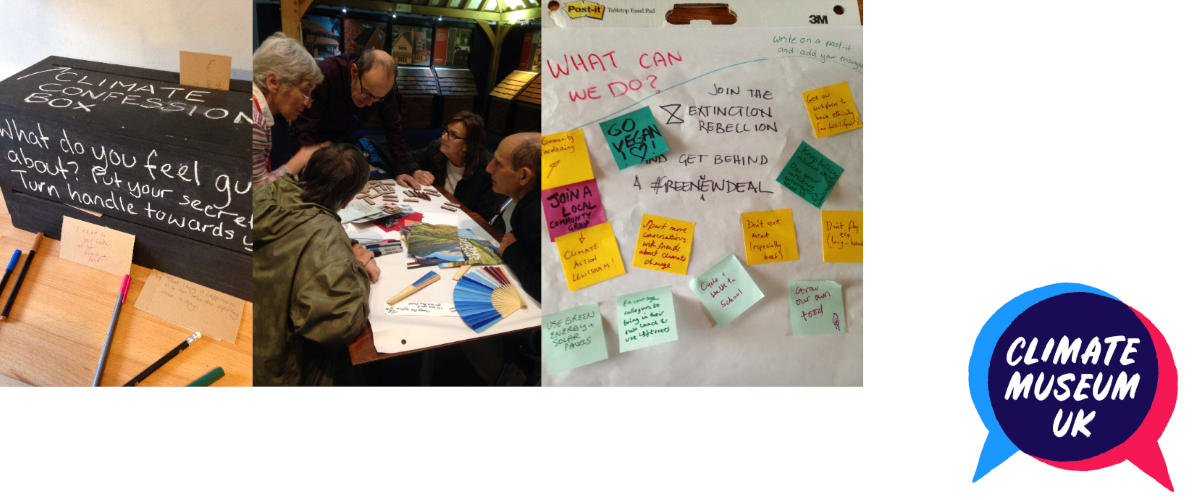
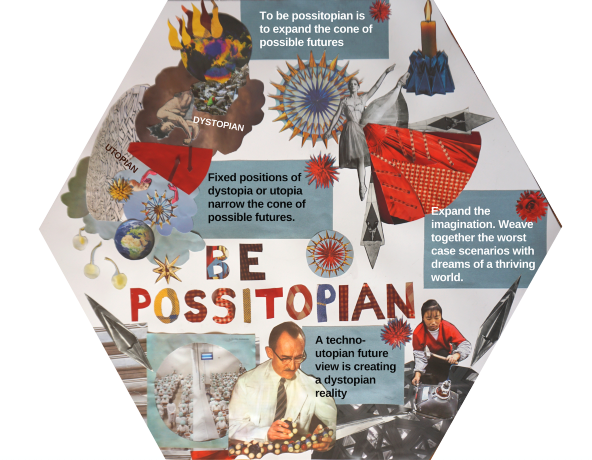
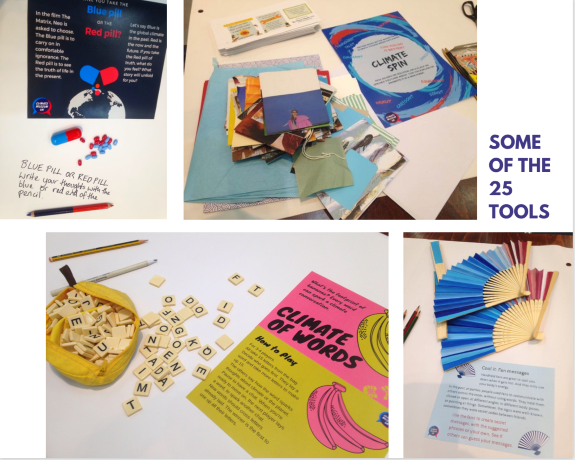
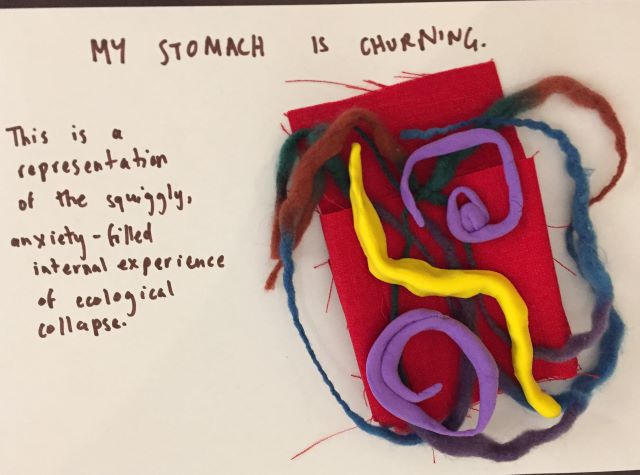
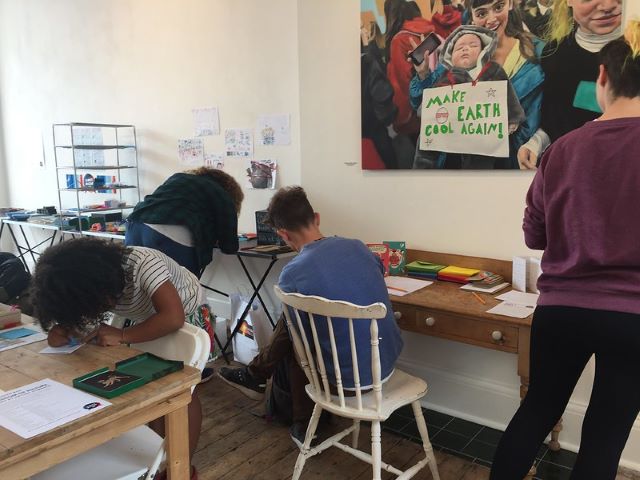

 Artikel drucken
Artikel drucken Literaturverzeichnis
Literaturverzeichnis